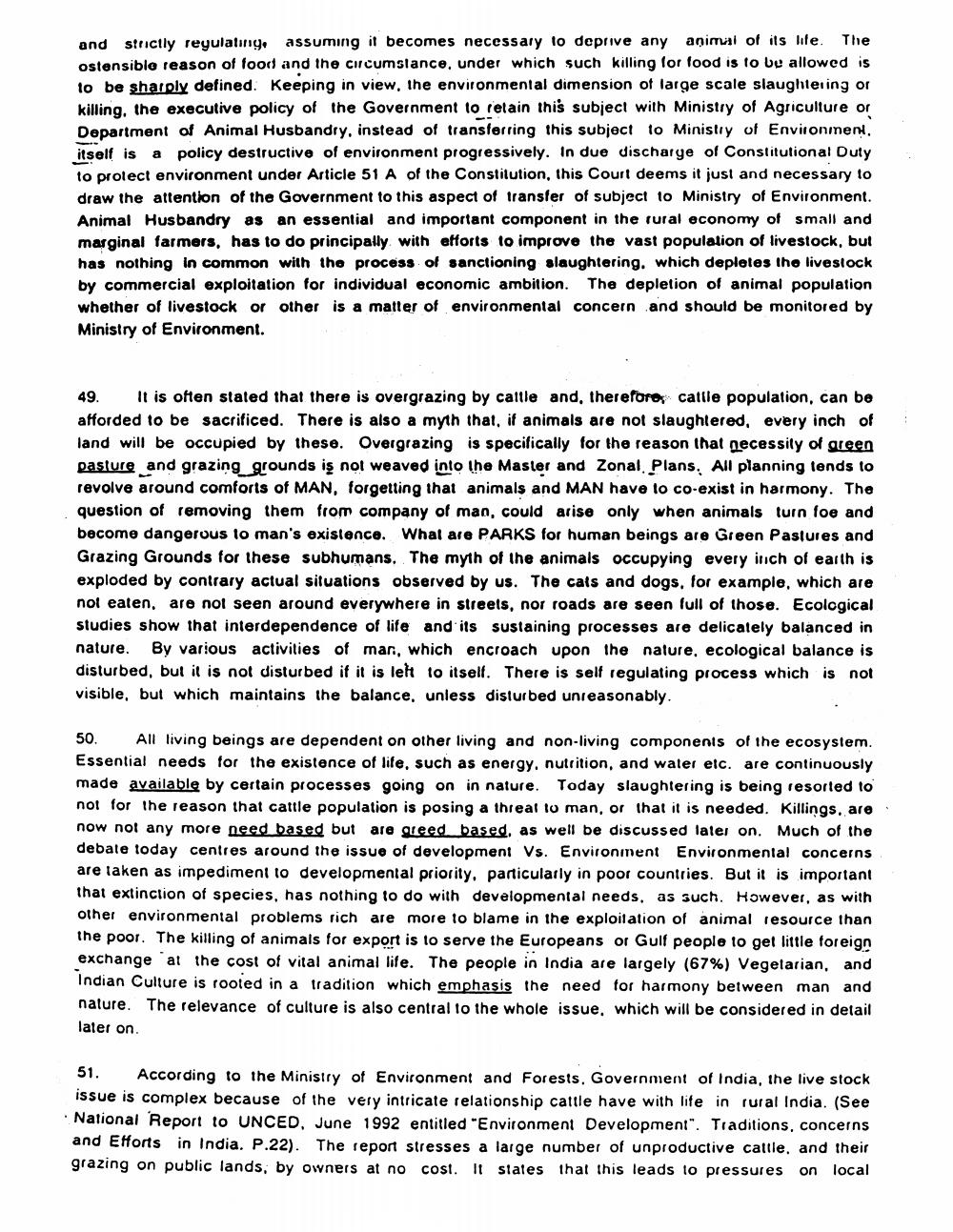________________
and strictly reyulating, assuming it becomes necessary to deprive any animal of its life. The ostensible reason of food and the circumstance, under which such killing for food is to be allowed is to be sharply defined. Keeping in view. the environmental dimension of large scale slaughtering or killing. the executive policy of the Government to retain this subject with Ministry of Agriculture or Department of Animal Husbandry, instead of transferring this subject to Ministry of Environment. itself is a policy destructive of environment progressively. In due discharge of Constitutional Duty to protect environment under Article 51 A of the Constitution, this Court deems it just and necessary to draw the attention of the Government to this aspect of transfer of subject to Ministry of Environment. Animal Husbandry as an essential and important component in the rural economy of small and marginal farmers, has to do principally with efforts to improve the vast population of livestock, but has nothing in common with tho process of sanctioning slaughtering. which depletes the livestock by commercial exploitation for individual economic ambition. The depletion of animal population whether of livestock or other is a matter of environmental concern and should be monitored by Ministry of Environment.
49. It is often stated that there is overgrazing by cattle and, therefore, cattle population, can be afforded to be sacrificed. There is also a myth that, if animals are not slaughtered, every inch of land will be occupied by these. Overgrazing is specifically for the reason that necessity of green pasture and grazing grounds is not weaved into the Master and Zonal. Plans. All planning tends to revolve around comforts of MAN, forgetting that animals and MAN have to co-exist in harmony. The question of removing them from company of man, could arise only when animals turn foe and become dangerous to man's existence. Whal are PARKS for human beings are Green Pastures and Grazing Grounds for these subhumans. The myth of the animals occupying every inch of earth is exploded by contrary actual situations observed by us. The cals and dogs, for example, which are not eaten, are not seen around everywhere in streets, nor roads are seen full of those. Ecological studies show that interdependence of life and its sustaining processes are delicately balanced in nature. By various activities of mar, which encroach upon the nature, ecological balance is disturbed, but it is not disturbed if it is lelt to itself. There is self regulating process which is not visible, but which maintains the balance, unless disturbed unreasonably.
50. All living beings are dependent on other living and non-living components of the ecosystem. Essential needs for the existence of life, such as energy, nutrition, and water etc. are continuously made available by certain processes going on in nature. Today slaughtering is being resorted to not for the reason that cattle population is posing a threat to man, or that it is needed. Killings. are now not any more need based but are aceed_based, as well be discussed later on. Much of the debate today centres around the issue of development Vs. Environment Environmental concerns are taken as impediment to developmental priority, particularly in poor countries. But it is important that extinction of species, has nothing to do with developmental needs, as such. However, as with other environmental problems rich are more to blame in the exploitation of animal resource than the poor. The killing of animals for export is to serve the Europeans or Gulf people to get little foreign exchange at the cost of vital animal life. The people in India are largely (67%) Vegetarian, and Indian Culture is rooted in a tradition which emphasis the need for harmony between man and nature. The relevance of culture is also central to the whole issue, which will be considered in detail later on.
51. According to the Ministry of Environment and Forests. Government of India, the live stock issue is complex because of the very intricate relationship cattle have with life in rural India. (See · National Report to UNCED, June 1992 entitled "Environment Development". Traditions, concerns and Efforts in India. P.22). The report stresses a large number of unproductive cattle, and their grazing on public lands, by owners at no cost. It states that this leads to pressures on local




